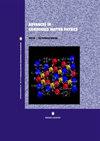The Study of Transport Properties of (III−Mn) V Diluted Magnetic Semiconductors
IF 1.8
4区 物理与天体物理
Q3 PHYSICS, CONDENSED MATTER
引用次数: 0
Abstract
We investigated the transport properties of diluted magnetic semiconductors (DMSs) theoretically by using the Heisenberg and Ruderman–Kittel–Kasuya–Yosida (RKKY) exchange interaction models by considering both spin and charge disorder. The formalism is applied to the specific case of Ga 1 − x Mn x As . Using the Heisenberg model and the Green function formalism the total thermal excitation of the magnon is calculated. The magnetization and Curie temperature of Mn -doped GaAs is calculated. The theoretical calculation of T C of Ga 1 − x Mn x As at x = 0.08 has a good agreement with the experimental calculation at x = 0.08 (i.e., 162 k). The exchange interaction constant and spin-dependent relaxation time is calculated by using RKKY interaction. The electrical conductivity and hole mobility are calculated by using the Boltzmann transport equation and the spin-dependent relaxation time. The electrical conductivity of Mn -doped III–V DMS is exponentially increased with temperature and magnetic impurity concentration. Hole mobility of Mn -doped III–V diluted magnetic semiconductor is increased with the magnetic impurity concentration.(III−Mn) V稀释磁性半导体输运性质的研究
利用Heisenberg和Ruderman-Kittel-Kasuya-Yosida (RKKY)交换相互作用模型,在考虑自旋和电荷无序的情况下,从理论上研究了稀释磁性半导体(dms)的输运性质。该公式适用于Ga 1−x Mn x As的特殊情况。利用海森堡模型和格林函数形式,计算了磁振子的总热激发。计算了掺杂锰的砷化镓的磁化强度和居里温度。Ga 1−x Mn x As在x = 0.08时的理论计算结果与x = 0.08(即162 k)时的实验计算结果吻合较好。利用RKKY相互作用计算了交换相互作用常数和自旋相关的弛豫时间。利用玻尔兹曼输运方程和自旋相关弛豫时间计算了电导率和空穴迁移率。Mn掺杂的III-V DMS的电导率随温度和磁性杂质浓度呈指数增长。Mn掺杂的III-V稀释磁性半导体的空穴迁移率随磁性杂质浓度的增加而增加。
本文章由计算机程序翻译,如有差异,请以英文原文为准。
求助全文
约1分钟内获得全文
求助全文
来源期刊

Advances in Condensed Matter Physics
PHYSICS, CONDENSED MATTER-
CiteScore
2.30
自引率
0.00%
发文量
33
审稿时长
6-12 weeks
期刊介绍:
Advances in Condensed Matter Physics publishes articles on the experimental and theoretical study of the physics of materials in solid, liquid, amorphous, and exotic states. Papers consider the quantum, classical, and statistical mechanics of materials; their structure, dynamics, and phase transitions; and their magnetic, electronic, thermal, and optical properties.
Submission of original research, and focused review articles, is welcomed from researchers from across the entire condensed matter physics community.
 求助内容:
求助内容: 应助结果提醒方式:
应助结果提醒方式:


